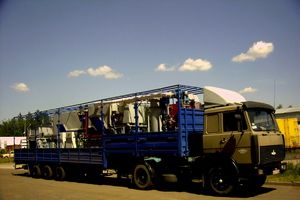Main Sector of relevance\IRC classification 6. Energy
6.3 Modular mobile plant UTRO-500

Developers’ contact information
State Scientific Institution “The A.V.Lykov Institute of Heat and Mass Transfer of National Academy of Sciences of Belarus”
15 P.Brovka Street, Minsk BY-220072
Tel.: +375 (17) 284-22-41
Summary
Thermal treatment plant for technical rubber wastes UTRO-500 is designed mainly for average temperature (400–600 °C) thermal decomposition of worn-out tires in overheated aqueous vapour medium or vapor-gas mixture (aqueous vapour plus technical rubber gaseous decomposition products).The outcome of the process is composite liquid fuel and metallic scrap (if any metal is present in waste materials).
Description
The essence of the method is in special heat treatment of
technical rubber wastes (worn-out tires) resulting in rubber thermolysis and
generation of solid, liquid and gaseous phases.
The resulting rubber waste thermolysis products are as follows:
Technology type
Technical advantages and economic benefits
High ecological performance and power efficiency. A possibility to produce alternative types of fuel from production and consumer wastes.
Technology differentiation and uniqueness
The innovative component is represented by application of vapour thermolysis in organic waste heat treatment process.
Context in which technology was identified
In 2006 the technology was presented at the VIth Moscow Salon of
Innovations where it was nominated for the Grand-Prix and was awarded with a
gold medal.
In 2006 at the exhibition in Shen-Zen (People’s Republic of China) held under
the auspices of the United Nations Industrial Development Organization and was
awarded with the Blue Sky diploma.
In 2007 at the International exhibition in St. Petersburg the technology was
awarded with a special prize as “The best innovative project in the sphere of
ecology and environmental management”.
Technological keywords
Thermolysis, organic wastes, vapour.
Development Stage
Intellectual property rights
Range of applications
Organic waste treatment.
Classifier Used at the EU Innovation Relay Centres
Preferable Regions
Practical experience
The process is tested on UTRO-1 plant.
Environmental impact
None.
Type of collaboration sought
Terms and restrictions
—
Available technical assistance